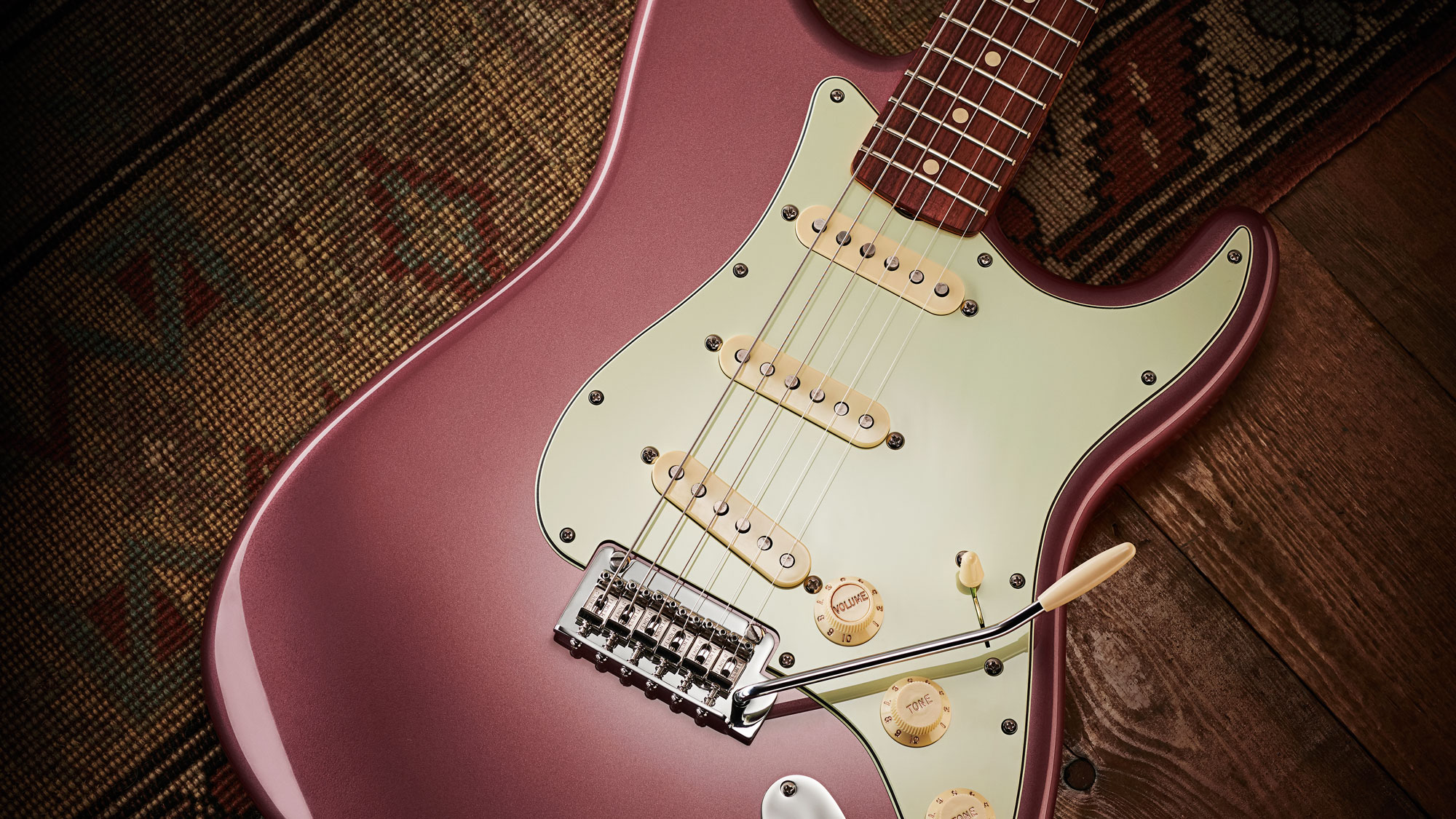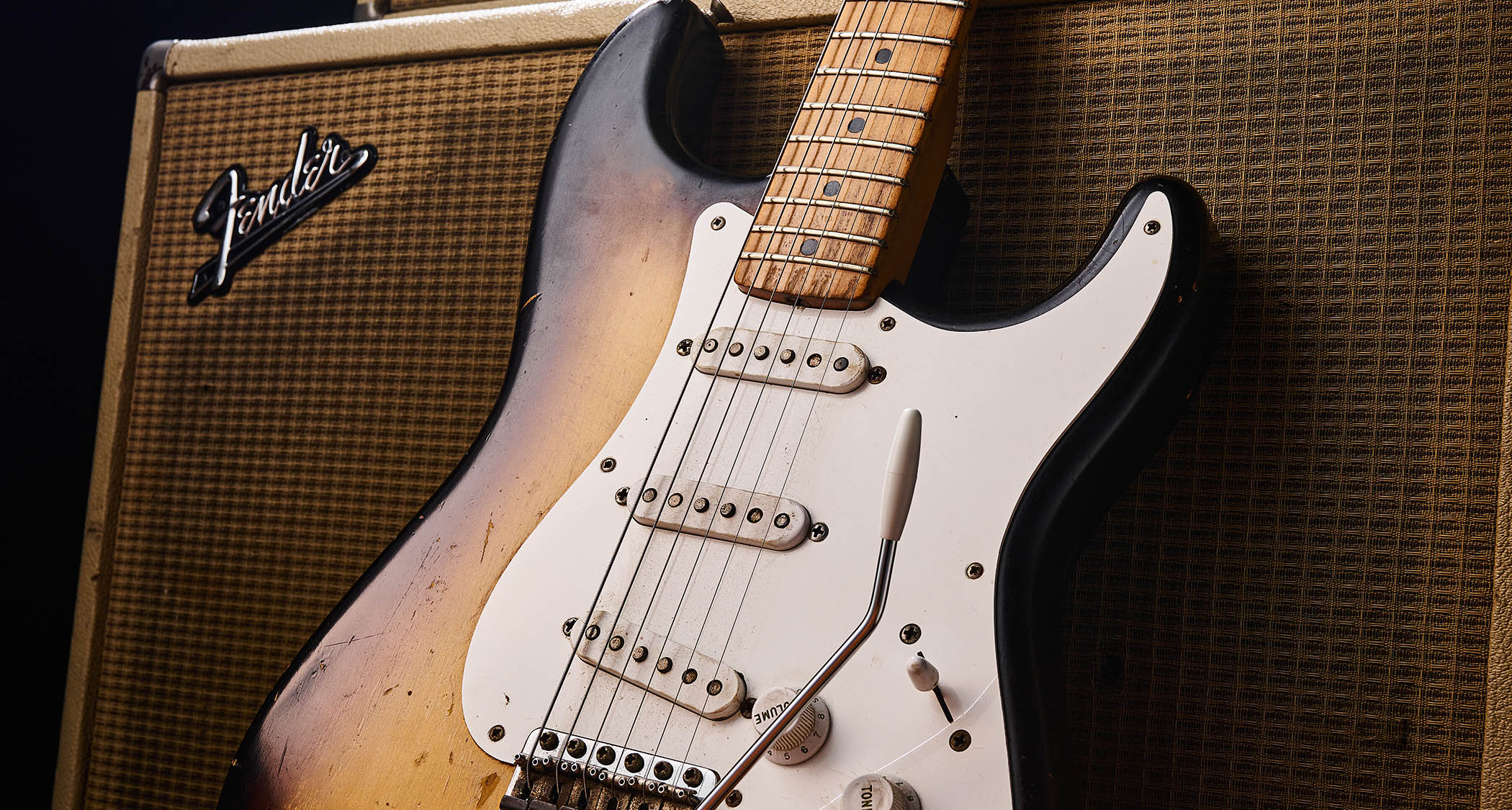
What makes one Fender Stratocaster ordinary and another out of this world? It’s a question players have pondered for the last seven decades – and who better to explain than Master Builders Paul Waller and Austin MacNutt of Fender’s Custom Shop.
We join them to talk vintage tone, miracle mods and sanding – lots of sanding…
Which is the greatest era of Strat in your personal opinion?
Paul Waller: “For me, it’s early ’60s. I think that’s when the Strat really started to come into its own. Putting the rosewood on there, slimming out the neck, and the pickups started getting dialled in to really make what pure Strat sounds are for me.”
Austin MacNutt: “I like the late-’50s Strats – just the classic look. They all look great, but I feel like they really got it right, right out of the gate.”
What do you regard as an ideal weight for a Strat?
Paul: “I personally like just under 8lbs – maybe 7¾lbs.”
Austin: “Yeah, that’s a good range. I’m not terribly picky about it, honestly. I’ve got Strats all over the weight spectrum [in my personal collection] and I don’t tend to go for one more than the other because of the weight – it doesn’t affect my choice as much as [it might for] some people.”
What’s your favourite body wood for a Strat?
Austin: “I have go to with ash. I love the look of it, especially if you can get a nice, lightweight piece. And they’re out there. I like seeing the grain – it’s a little more interesting than an alder body, speaking personally.”
Paul: “Yeah, I really like ash-body Strats and it’s a dirty little secret that, because I like the ’60s neck, when I get a customer that orders an ash-body ’60s, I’m like, ‘My dude!’ [laughs]”

What are your favourite electric guitar pickups for Strats?
Paul: “It’s tough.”
Austin: “That is tough.”
Paul: “Do you want to go first?”
Austin: “I feel like it’s a revolving door… I mean, I just finished one that had Ancho Poblanos in it and I was just playing it and I was like, ‘Wow, this sounds really good.’
Paul: “I almost feel like certain pickups might sound better in certain combinations, but, yeah, it definitely moves around for me. I’ve designed sets of pickups that we have here and I’ve put a lot of those sets in guitars, and they tend to be on the lower-output side, more like a vintage [set]. But, then, I also really like ’69s, anything with enamel [wire].

“The set I designed actually has one enamel in it, in the neck, so you can get that really fat ‘Jimi’ stuff with it, but then I also like the ’62s as well. So that was my way of getting the best of both worlds: having a ’62 set in the bridge and middle, and an enamel ’69 in the neck. That was a fun set to do. I get a lot of orders for those.
“But it’s so hard to say what’s best because they’re all so good. Especially when you have access to the winders that are making the premium stuff. Pickups are also easily altered by adding copper or taking copper away, mixing magnets… It’s quite a soup recipe with a lot of ingredients that can be changed very easily.”
A lot of players want Strats with quarter-sawn maple necks. What benefits does a quarter-sawn neck bring, in lutherie terms?
Paul: “One of the guys here took a piece of maple and cut it into a 1x1-inch cube and we made sure it was dimensionally the same in both grain directions with a calliper. Then we put it in a press and measured the deflection from point A to point B – you know, the deflection in the middle [when both ends were subjected to a high-pressure load] – and it was the same in both flat-sawn and quarter-sawn.
“So that really spoke to how maple is one of those materials where it’s already really strong, even without the grain orientation. So I would say ‘stability’ is a word that people should be using, not ‘strength’ when it comes to grain orientation. A [quarter-sawn maple neck] is going to be a more stable neck, probably, but not necessarily any stronger.”

What are your thoughts on using roasted or torrified maple in Strat necks?
Austin: “I like it. It has a nice look. It oils up well if you’re going down that route of an oiled neck; it feels great.”
Paul: “I like it, too – I would say the light-roasted version, though. Anything beyond that starts to get too brittle for me and you can get other issues with cracking, and I would be concerned about the longevity of the instrument.
“I mean, Fenders are designed and built to last forever, so material is an important aspect of that. Anything beyond a light roast I’m not going to be interested in. That has to do with experience of having issues with the darker roasted pieces.”

Tell us a really cool setup tip or maintenance tip for Strats.
Paul: “Just leave the bridge alone. The traditional Fender [Strat bridge setup] is the floating bridge. And that’s fine if you’re using the bar all the time. But, after speaking with a lot of guys, they’re not really hammering on the bar. Maybe it’s for a specific song or something… but not too many live in that world all the time.
I set up Strats where the bridge is actually sitting on the face of the guitar. That way, it’ll always come back to pitch and you don’t have to worry about putting your thumb on it and changing its pitch
Paul Waller
“And so now I set up Strats where the bridge is actually sitting on the face of the guitar. That way, it’ll always come back to pitch and you don’t have to worry about putting your thumb on it and changing its pitch. Then, if you decide you want to use the bar, you can put the bar in and dive it, which would satisfy most people.
“For the few that want the floating bridge, you can float your bridge, but you’re just asking for trouble at that point. That’s why things like Floyd Rose exist, because of floating bridges, and the type of music that came out of that era.
“That was a problem that needed to be solved and so [the Floyd Rose] came about. But, now, with today’s music, that’s not really necessary so much. Running with the trends of how guitar players are playing today, that’s how I set mine up and I would suggest anybody do it that way.”

Some players believe that hardtail Strats have something extra-special about them. What are your thoughts on that?
Austin: “They have a different feel to it, for sure. Yeah, I like them.”
Paul: “I do, too. I’ve always liked them because I’ve always been into Teles, so it was an easy segue for me to do a hardtail Strat. But I would say that they’re a bit more hit and miss than a standard Strat. Hardtails are more like Teles, where there tends to be a bit more variance and good ones and bad ones. But when you get a good one it’s like, ‘Oh boy, what have I been missing?’ They can be special, for sure.”
I like having the ‘blender’ in it, so you have volume, tone and the blender. I think that’s incredibly useful
Austin MacNutt
What are your personal favourite electronics mods for Strats?
Austin: “I like having the ‘blender’ in it, so you have [three knobs that control] volume, tone and the blender [allowing bridge-and-neck and all three pickups to be engaged at once]. I think that’s incredibly useful.”
Paul: “I’ve been doing that a lot lately, too, especially with a humbucker [in HSS builds], because now you can get the humbucker and the neck [using] the blender. I would say in the last 20 years, that’s been one of the greater upgrades for the Strat. Because you really can’t fix much on the Strat, but that helped bring in some stuff and now somebody that’s maybe playing country can kind of get a Tele thing out of it with the blender.”
What’s the best Strat you’ve ever played?
Austin: “I did a refret on a ’58 years ago that someone brought me, that one just sounded amazing. Maybe it was just one of the first vintage ones I worked on, but I played that one for a while before I called the owner and had him come pick it up!”
Paul: “That’s a tough question. A couple that stick out – Ronnie Wood has a hardtail Strat and that one was incredible, I think it was a ’55. And then Nile Rodgers’ Hitmaker Strat, that one’s incredible.”







